Blog & Latest Updates
Fly Fishing Articles
Insects by Common Name


Animal Phylum Arthropoda (Arthropods)
Taxonomic Navigation -?-
Kingdom
Animalia (Animals)
» Phylum Arthropoda (Arthropods)
| Class in Arthropoda | ||
| ArachnidaMites and Spiders | 0 | 1 |
| CollembolaSpringtails | 0 | 0 |
| Crustacea-MalacostracaCrayfish, Scuds, and Sowbugs | 0 | 10 |
| Crustacea-Maxillopoda | 0 | 0 |
| InsectaInsects | 0 | 114 |
Common Name
| Match | Common Name |
| Arthropods |
This is page 9 of specimens of Arthropoda. Visit the main Arthropoda page for:
- The behavior and habitat of Arthropoda.
- 122 underwater pictures of Arthropoda.
Pictures of 1244 Arthropod Specimens:
Female Baetisca laurentina (Armored Mayfly) Mayfly Spinner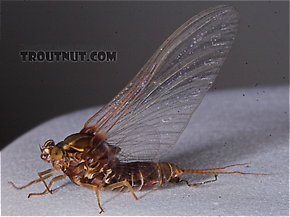 View 9 Pictures
View 9 Pictures
 View 9 Pictures
View 9 PicturesCollected June 1, 2005 from the Bois Brule River in Wisconsin
Added to Troutnut.com by Troutnut on May 24, 2006
Added to Troutnut.com by Troutnut on May 24, 2006
Maccaffertium ithaca (Light Cahill) Mayfly Dun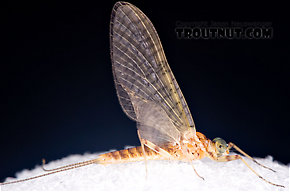 View 9 PicturesThis dun emerged from a nymph in one of the bowls on my table while I was sorting. I photographed it with the nymphal shuck (
View 9 PicturesThis dun emerged from a nymph in one of the bowls on my table while I was sorting. I photographed it with the nymphal shuck (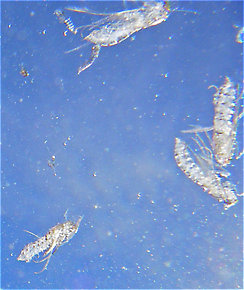 Shuck: The shed exoskeleton left over when an insect molts into its next stage or instar. Most often it describes the last nymphal or pupal skin exited during emergence into a winged adult.), and it seems to be of the same species as a nymph I photographed from the same sample.
Shuck: The shed exoskeleton left over when an insect molts into its next stage or instar. Most often it describes the last nymphal or pupal skin exited during emergence into a winged adult.), and it seems to be of the same species as a nymph I photographed from the same sample.
 View 9 PicturesThis dun emerged from a nymph in one of the bowls on my table while I was sorting. I photographed it with the nymphal shuck (
View 9 PicturesThis dun emerged from a nymph in one of the bowls on my table while I was sorting. I photographed it with the nymphal shuck (
Here's an underwater view of the pupal shucks of several already-emerged Brachycentrus numerosus caddisflies.
Collected May 29, 2007 from Paradise Creek in Pennsylvania
Added to Troutnut.com by Troutnut on June 4, 2007
Added to Troutnut.com by Troutnut on June 4, 2007
Epeorus (Little Maryatts) Mayfly Nymph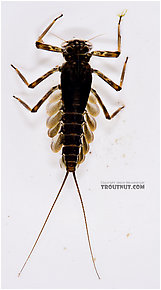 View 9 Pictures
View 9 Pictures
 View 9 Pictures
View 9 PicturesCollected May 6, 2007 from Mongaup Creek in New York
Added to Troutnut.com by Troutnut on May 18, 2007
Added to Troutnut.com by Troutnut on May 18, 2007
Male Paraleptophlebia (Blue Quills and Mahogany Duns) Mayfly Spinner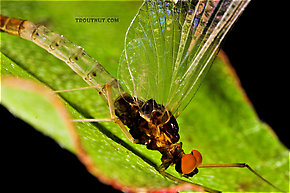 View 15 PicturesI wasn't actually fishing the river where I caught this one. I was just scouting, didn't like the look of the water, and as I was walking back to the car this little dun landed on my vest. Why can't they all be so easy to collect?
View 15 PicturesI wasn't actually fishing the river where I caught this one. I was just scouting, didn't like the look of the water, and as I was walking back to the car this little dun landed on my vest. Why can't they all be so easy to collect?
 View 15 PicturesI wasn't actually fishing the river where I caught this one. I was just scouting, didn't like the look of the water, and as I was walking back to the car this little dun landed on my vest. Why can't they all be so easy to collect?
View 15 PicturesI wasn't actually fishing the river where I caught this one. I was just scouting, didn't like the look of the water, and as I was walking back to the car this little dun landed on my vest. Why can't they all be so easy to collect?Collected September 8, 2006 from the East Branch of the Delaware River in New York
Added to Troutnut.com by Troutnut on October 4, 2006
Added to Troutnut.com by Troutnut on October 4, 2006
Male Stenacron interpunctatum (Light Cahill) Mayfly Spinner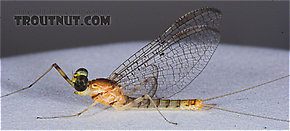 View 8 Pictures
View 8 Pictures
 View 8 Pictures
View 8 PicturesCollected June 10, 2005 from the Namekagon River in Wisconsin
Added to Troutnut.com by Troutnut on May 26, 2006
Added to Troutnut.com by Troutnut on May 26, 2006
Brachycentrus (Grannoms) Caddisfly Pupa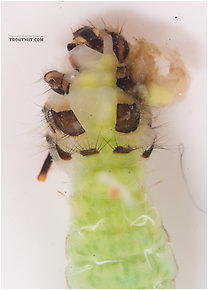 View 10 PicturesThe green blob contained in this case is a pupa in the early stages of transformation from larva to the final stage we generally picture and imitate. This specimen and several like it were fixed to a rock I picked up, and each one had the front of its case sealed off, protecting the helpless pupa from predation. It's neat to see the insect part-way through such a radical transformation.
View 10 PicturesThe green blob contained in this case is a pupa in the early stages of transformation from larva to the final stage we generally picture and imitate. This specimen and several like it were fixed to a rock I picked up, and each one had the front of its case sealed off, protecting the helpless pupa from predation. It's neat to see the insect part-way through such a radical transformation.
It was very hard to extract this thing from its case, so there's a bit of extra goo near the head from where I accidentally punctured it.
 View 10 PicturesThe green blob contained in this case is a pupa in the early stages of transformation from larva to the final stage we generally picture and imitate. This specimen and several like it were fixed to a rock I picked up, and each one had the front of its case sealed off, protecting the helpless pupa from predation. It's neat to see the insect part-way through such a radical transformation.
View 10 PicturesThe green blob contained in this case is a pupa in the early stages of transformation from larva to the final stage we generally picture and imitate. This specimen and several like it were fixed to a rock I picked up, and each one had the front of its case sealed off, protecting the helpless pupa from predation. It's neat to see the insect part-way through such a radical transformation.It was very hard to extract this thing from its case, so there's a bit of extra goo near the head from where I accidentally punctured it.
Collected April 14, 2007 from Cayuta Creek in New York
Added to Troutnut.com by Troutnut on April 22, 2007
Added to Troutnut.com by Troutnut on April 22, 2007
Hydropsyche (Spotted Sedges) Caddisfly Pupa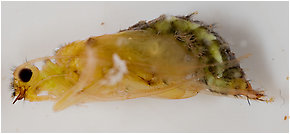 View 8 PicturesSeveral users have interesting comments in the discussion of this specimen, but this observation by Creno is especially good:
View 8 PicturesSeveral users have interesting comments in the discussion of this specimen, but this observation by Creno is especially good:
 View 8 PicturesSeveral users have interesting comments in the discussion of this specimen, but this observation by Creno is especially good:
View 8 PicturesSeveral users have interesting comments in the discussion of this specimen, but this observation by Creno is especially good:Also, this is what I would call an "immature" pupa. The wingpads of caddis pupae darken to nearly black as the enclosed adults near emerging. The darkening is the developing adult wing inside the pupal wing pad (Wing pad: A protrusion from the thorax of an insect nymph which holds the developing wings. Black wing pads usually indicate that the nymph is nearly ready to emerge into an adult.). The ultimate coloration of the adult wing is not very apparent in most pupal wing pads (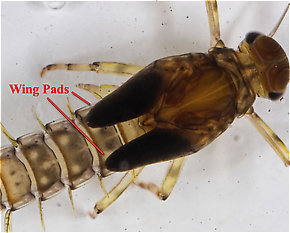 The wing pads on this final instar Baetidae mayfly nymph are extremely dark.Wing pad: A protrusion from the thorax of an insect nymph which holds the developing wings. Black wing pads usually indicate that the nymph is nearly ready to emerge into an adult.) as the majority of the adult wing coloration comes from the color/position of the adult wing hairs and setae (Seta: Little hairs on insects.). But dark pupal wingpads are a good indication that the emergence will occur very soon, likely that day or so, and that the adult parts are sufficiently developed within the pupae to make a species determination from the specimen, particularly if it is a male.
The wing pads on this final instar Baetidae mayfly nymph are extremely dark.Wing pad: A protrusion from the thorax of an insect nymph which holds the developing wings. Black wing pads usually indicate that the nymph is nearly ready to emerge into an adult.) as the majority of the adult wing coloration comes from the color/position of the adult wing hairs and setae (Seta: Little hairs on insects.). But dark pupal wingpads are a good indication that the emergence will occur very soon, likely that day or so, and that the adult parts are sufficiently developed within the pupae to make a species determination from the specimen, particularly if it is a male. The wing pads on this final instar Baetidae mayfly nymph are extremely dark.
The wing pads on this final instar Baetidae mayfly nymph are extremely dark.
Collected May 13, 2007 from the Delaware River in New York
Added to Troutnut.com by Troutnut on May 18, 2007
Added to Troutnut.com by Troutnut on May 18, 2007
Male Rhithrogena morrisoni (Western March Brown) Mayfly Spinner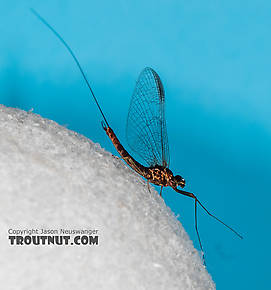 View 9 Pictures
View 9 Pictures
 View 9 Pictures
View 9 PicturesCollected June 22, 2017 from the South Fork Snoqualmie River in Washington
Added to Troutnut.com by Troutnut on June 23, 2017
Added to Troutnut.com by Troutnut on June 23, 2017
Male Epeorus pleuralis (Quill Gordon) Mayfly Spinner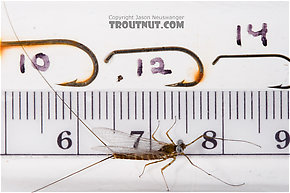 View 10 PicturesA few days earlier I photographed this same specimen as a dun. The changes between dun and spinner seem particularly dramatic in this species.
View 10 PicturesA few days earlier I photographed this same specimen as a dun. The changes between dun and spinner seem particularly dramatic in this species.
 View 10 PicturesA few days earlier I photographed this same specimen as a dun. The changes between dun and spinner seem particularly dramatic in this species.
View 10 PicturesA few days earlier I photographed this same specimen as a dun. The changes between dun and spinner seem particularly dramatic in this species.Collected April 30, 2007 from Dresserville Creek in New York
Added to Troutnut.com by Troutnut on May 3, 2007
Added to Troutnut.com by Troutnut on May 3, 2007
Female Hexagenia limbata (Hex) Mayfly Dun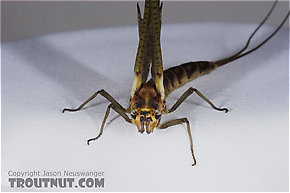 View 8 Pictures
View 8 Pictures
 View 8 Pictures
View 8 PicturesCollected June 13, 2005 from the Namekagon River in Wisconsin
Added to Troutnut.com by Troutnut on May 26, 2006
Added to Troutnut.com by Troutnut on May 26, 2006
Top 10 Fly Hatches
Top Gift Shop Designs
Eat mayflies.
Top Insect Specimens
Miscellaneous Sites
Troutnut.com is copyright © 2004-2024 Jason
Neuswanger (email Jason). See my FAQ for information about use of my images.
 privacy policy
privacy policy
